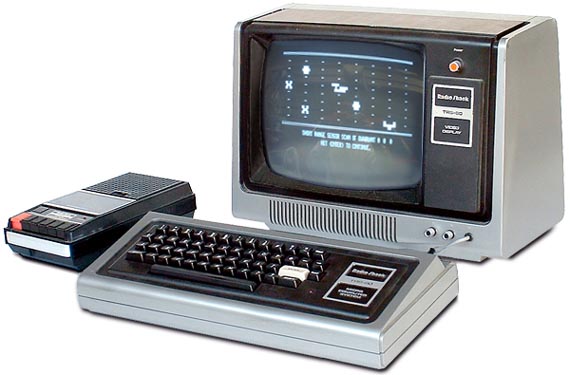Remembering Radio Shack

With Radio Shack having declared Chapter 11 bankruptcy, with hundreds of stores closing and others possibly becoming Sprint locations, let’s take a moment to look back at the important contributions the company made in the early days of personal computing.
Charles Tandy started the Tandy Leather Company which opened hundreds of little shops in the 1950s selling kits for consumers to make their own tooled leather belts, for example. I made one in 1959, burning my name into the belt with a soldering iron. As leather craft faded as a hobby and electronics boomed many of those Tandy Leather stores became Radio Shacks (but not all -- a few leather stores survive even today). Radio Shack stores always had the advantage of proximity balanced by higher prices. If you needed a part or two you drove down to Radio Shack but if you had a bunch of electronic parts to buy there was generally some cheaper store across town.
Even today you can buy a $35 Raspberry Pi computer from the Raspberry Pi Foundation or a $121 Raspberry Pi kit from Radio Shack. No wonder the Shack is in trouble.
Just as Jack Tramiel’s Commodore rode the 1970’s handheld calculator boom, Radio Shack rode that decade’s even bigger CB Radio boom. But as each boom faded the two companies had to find the Next Big Thing, so they both turned to personal computers.
Radio Shack found its salvation in Steve Leininger, an employee at Paul Terrell’s Byte Shop in Mountain View where the original Apple 1s were sold. Leininger designed the TRS-80 that was to become, from 1978-82, the fastest selling computer in the world -- bigger at the time than even the Apple II. The barebones TRS-80 cost $199.95 in a pretty much unusable form and about $1800 completely tricked out. The TRS-80 was fabulously successful.
Not so successful but equally important to computer history was Radio Shack’s answer to the IBM PC, the Model 2000, which appeared in the fall of 1983. The Model 2000 was intended to beat the IBM PC with twice the speed, more storage, and higher-resolution graphics. The trick was its more powerful processor, the Intel 80186, which could run rings around IBM’s old 8088.
Because Tandy had its own distribution through 5,000 Radio Shack stores and through a chain of Tandy Computer Centers, the company thought for a long time that it was somehow immune to the influence of the IBM PC standard. The TRS-80, after all, was a proprietary design and a huge success. Tandy thought of their trusty Radio Shack customers as Albanians who would loyally shop at the Albanian Computer Store, no matter what was happening in the rest of the world. Alas, it was not to be so.
Bill Gates was a strong believer in the Model 2000 because it was the only mass market personal computer powerful enough to run new software from Microsoft called Windows without being embarrassingly slow. For Windows to succeed, Bill Gates needed a computer like the Model 2000 available everywhere. So young Bill, who handled the Tandy account himself, predicted that the computer would be a grand success -- something the boys and girls at Tandy HQ in Fort Worth wanted badly to hear. And Gates made a public endorsement of the Model 2000, hoping to sway customers and promote Windows as well.
Still, the Model 2000 failed miserably. Nobody gave a damn about Windows 1, which didn’t appear until 1985, and even then didn’t work well. The computer wasn’t hardware compatible with IBM. It wasn’t very software compatible with IBM either, and the most popular IBM PC programs -- the ones that talked directly to the PC’s memory and so worked faster than those that allowed the operating system to do the talking for them -- wouldn’t work at all. Even the signals from the keyboard were different from IBM’s, which drove software developers crazy and was one of the reasons that only a handful of software houses produced 2000-specific versions of their products.
Today the Model 2000 is considered the magnum opus of Radio Shack marketing failures. Worse, a Radio Shack computer buyer in his last days with the company for some reason ordered 20,000 more of the systems built even when it was apparent they weren’t selling. Tandy eventually sold 5,000 of those systems to itself, placing one in each Radio Shack store to track inventory. Some leftover Model 2000s were still in the warehouse in early 1990, almost seven years later.
Still, the Model 2000’s failure was Bill Gates’s gain. Windows 1 was a failure, but the head of Radio Shack’s computer division, Jon Shirley, the very guy who’d been duped by Bill Gates into doing the Model 2000 in the first place, sensed that his position in Fort Worth was in danger and joined Microsoft as president in 1983.
While Radio Shack still sells computers (at least for a few weeks longer) the company’s computer heyday peaked around 1980 -- 35 years ago.
Mobile phones offered the company a lifeline over the past decade but the positioning was all wrong. Those 1000+ Radio Shack stores that are rumored to be going to Sprint, for example, will represent the primary point of retail contact between the wireless carrier and subscribers valued by Wall Street at more than $2000 each. Sprint has far more to gain from each Radio Shack location it takes over than Tandy could ever have hoped to get from selling us batteries and speaker wire.
Where Radio Shack could no longer operate a profitable enough business in the age of Amazon Prime, for Sprint there’s still real value in neighborhood locations.
